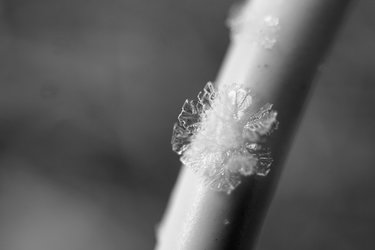Stop and (figuratively) smell the winter roses
The Albany Pine Bush is one of the best remaining inland pitch pine-scrub oak barrens in the world. It is a truly unique place right here in the Capital District. Through this column, I hope to transport you for at least a short time to the Pine Bush to experience some of the seasonal happenings, active projects, and musings of this environmental educator.
I have thought of winter as a visual palate cleanser. It rinses the color from the landscape, priming my eyes to acutely perceive even the most modest greens, reds, and purples of spring. I suspect this attitude is more a reflection of the bias in my attention, however, than a truth about winter.
Most of us spend much less time outside during the colder months. This is certainly true of me, and it limits my ability to observe winter’s intricacies and its variety. Imagine only ever viewing the summer from behind a window or in hurried travels between indoor locations. How much would you miss?
As a child, I paid more attention to the shapes of snowflakes, made a game of walking on the surface of crusted snow without breaking through, and knew that beneath the snow were last year’s plants — lying in a state of decay — and that disturbing them could release a startling scent into the otherwise cold, clean-smelling air. These memories inform me that my experience of winter in more recent years has been cursory at best. I’m determined to slow down and look a little closer this year, and I hope you will join me.
I can’t think of a winter wonder more appealing and pervasive than ice crystals. They are ephemeral, found in the forms of snowflakes and frost, and are reliably exquisite. Just as there are names for different species of wildflowers, there are names for the different forms of frozen and crystallized water that blanket the landscape and our windows in late fall, winter, and early spring.
It was on a nighttime hike through the Pine Bush last fall, while standing in a frost pocket at the base of a large dune, when I first learned there were names given to different forms of frost. A University at Albany student in our hiking group asked me whether I’d ever seen hoarfrost in the frost pockets.
That was the first time I’d heard the term hoarfrost, but I’ve since learned it forms when water vapor from the air crystallizes on surfaces of plants, snow, and other objects when those surfaces are below freezing and colder than the air itself. This can result in gorgeous, large, hexagonal crystals of ice attached to all surfaces of the cold objects. Hoarfrost generally forms on clear nights, and it helps if the air is humid and still, which is where frost pockets come in.
If you’ve ever hiked around the blue trail from the Albany Pine Bush Discovery Center, you’ve walked through at least one frost pocket. Frost pockets are low-lying areas where cold air settles in the evening and can linger late into the morning hours. The chilling effect in frost pockets is so significant, that plants and insects grow more slowly there. Frost pockets also tend to be protected from the wind, making them a good place to look for impressive hoarfrost.
My curiosity about hoarfrost led me back to that same frost pocket, early on a cold November morning, looking for something I wasn’t sure I could identify. There was plenty of frost, both on top of the dunes and down in the swales, and I spent the better part of an hour looking and photographing it.
I found “frost flowers,” which look like sheets of curling white filaments projecting from the stems of plants where liquid water was pushed out to freeze in the cold air. I saw sticks covered in ice bristles and round white balls coating the surfaces of leaves like pilled sweaters.
And on a piece of monitoring equipment used for recording the temperature and humidity in the frost pocket, I found a blooming cluster of flat, translucent crystals. Was this hoarfrost? I took photographs of the crystal clusters using a macro lens to better appreciate their complexity and headed back to the Discovery Center, satisfied with having stopped to (figuratively) smell the winter roses.
If you are interested in joining me on this investigation of winter in the Pine Bush, I encourage you to follow the Albany Pine Bush Preserve on Facebook, follow our blog on (www.AlbanyPineBush.org), or, best of all, head out onto the trails to experience it yourself. The preserve offers miles of official hiking trails to explore, free of charge, right here in the Capital Region. Please visit our website for information on temporary trail closures or call the Discovery Center Front Desk at (518) 456-0655 ahead of your visit.
